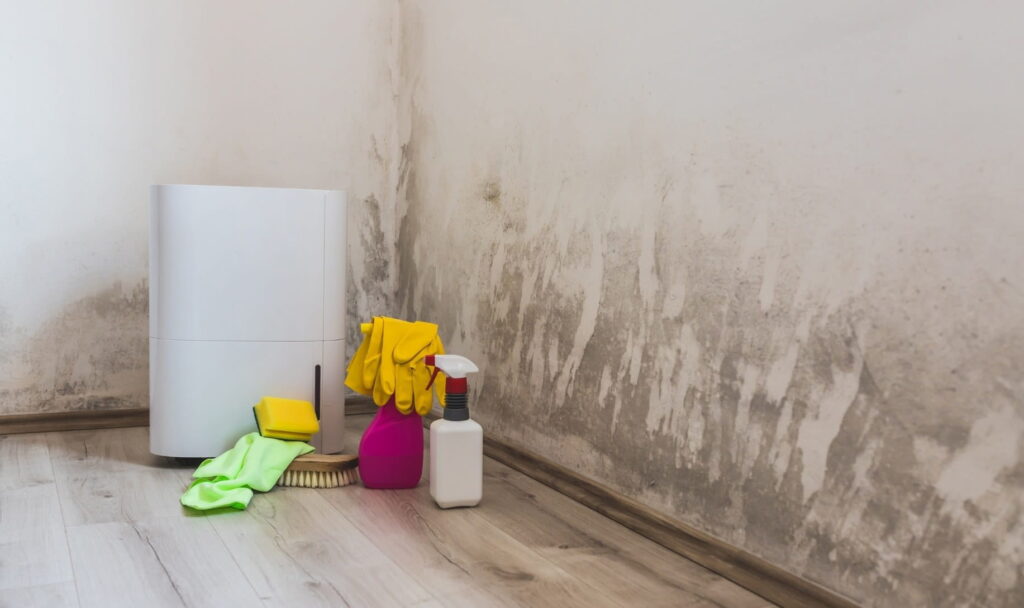
Can you paint over mould? If you are dealing with mould in your house, you might be wondering the same thing. The short answer is No, you cannot paint over mould.
Painting over mould will only hide it temporarily and make the problem worse. But if you follow the right anti-mould treatment, you can deal with it effectively. In this article, we will cover this common problem that many UK households face in their regular lifestyle.
Mould is a common problem in many homes, especially in damp and humid areas. It can cause health issues, such as allergies, asthma, and respiratory infections, as well as damage the appearance and structure of your walls and ceilings. If you want to get rid of mould and prevent it from coming back, you need to take some steps before painting over it. Here are some tips and tricks for painting over mould in your home.
1. Identify the Source and Extent of the Mould
To get rid of the mould in your home, you need to first identify where it is coming from and how much of it is there. Mould can grow due to various reasons, such as leaks, condensation, poor ventilation, or lack of insulation. These factors create moisture that allows the mould to thrive. You need to find and fix the source of the moisture as soon as possible. Otherwise, the mould will keep growing and spreading, even after you paint over it.
Next, you need to assess how deep the mould has penetrated into the surface. You can use a torch or a magnifying glass to inspect the affected areas. Depending on the depth of the mould, you may need different methods to remove it. If the mould is only on the surface, you can easily remove it with some cleaning products and tools. However, if the mould has gone deeper into the wall or ceiling, you may need to cut out and replace the damaged parts. You can also consult a professional mould remediation service if the mould is extensive or hard to reach.
2. Protect Yourself and the Surrounding Area
Before you start cleaning and painting over the mould, you need to take some precautions to protect yourself and the surrounding area. To avoid direct contact and inhalation of the mould, which can release spores and toxins, you should wear protective gear, such as gloves, goggles, mask, and coveralls.
To prevent the mould from spreading to other parts of your home, you should seal off the affected area with plastic sheets and tape, and cover the floor and furniture with drop cloths. To improve the ventilation and reduce the humidity, which can promote mould growth, you should also open the windows and doors.
3. Clean and Disinfect the Mouldy Surface

The next step is treat mould on walls before painting this envolves clean and disinfect the mouldy surface. You can use a variety of products and methods to do this, depending on the type and severity of the mould. Some of the most common products are bleach, vinegar, baking soda, hydrogen peroxide, and borax. You can also use commercial mould cleaners or fungicides that are specially designed to kill mould and prevent its growth. You should follow the instructions and safety precautions of the product you choose, and test it on a small area first to avoid damaging the surface.
To clean the mouldy surface, you need to spray or apply the product generously and let it sit for a few minutes. Then, you need to scrub the surface with a stiff bristle brush, sponge, or cloth to remove the mould. You may need to repeat this process several times until the mould is completely gone. After that, you need to rinse the surface with clean water and dry it thoroughly with a towel or a fan. You should also dispose of the cleaning materials and the protective gear properly, and wash your hands and clothes afterwards.
4. Apply a Mould-Resistant Primer
To prevent mould from growing on your walls or ceilings, you need to apply a mould-resistant primer after cleaning and drying the mouldy surface. A mould-resistant primer is a special type of primer that contains anti-microbial agents that can inhibit the growth of mould and other microorganisms. It can also seal the surface and prevent moisture from seeping through.
You should choose a primer that is suitable for the type and condition of the surface, and follow the directions and recommendations of the manufacturer. One example of a mould-resistant primer is Ronseal anti mould paint, which is a type of water-based emulsion that resists moisture and steam.
This primer can stop common mould from growing for up to six years, making it ideal for kitchens, bathrooms, cellars and anywhere else that attracts mould. You can either take help of a professional or apply the primer yourself. If you choose the latter option, make sure to apply the primer evenly and generously, and let it dry completely before painting over it.
5. Paint Over the Primed Surface
The final step is to paint over the primed surface with a damp seal paint that matches your preferences and needs. To ensure compatibility, check the labels of both the primer and the paint before applying them. Additionally, look for paints that have a low or zero VOC level, as these are less harmful to your health and the environment.
Follow the instructions and tips of the paint manufacturer to achieve the best results, and apply the paint in thin and even coats, letting each coat dry before applying the next one.
We hope you now have the answer to your question, ‘Can you paint over mould?‘ No, you can’t paint over mould to resolve the issue. Painting over mould will temporarily hide it, but the mould will continue to grow and can seep through the paint over time. Proper treatment and removal of the mould are necessary before painting.
Conclusion
By following these tips and tricks, you can successfully get rid of mould and restore the beauty and health of your walls and ceilings.
However, you should also remember that painting over mould is not a permanent solution, and you need to address the underlying causes and prevent the recurrence of mould in your home. You should also seek professional help if the mould is severe or beyond your ability to handle.
About Damp2Dry Solutions Ltd.
Damp2Dry Solutions Ltd is a leading provider of mould removal and damp proofing services, dedicated to protecting your home or business from damp and mould. Our team of experts excels in quick and meticulous mould removal, eradicating any traces of this potential health risk. Moreover, our damp proofing services offer a complete solution to safeguard your property from moisture-related problems, avoiding structural damage and ensuring a safe environment. Trust Damp2Dry Solutions Ltd for reliable and effective services that put the health and integrity of your living or working space first.
